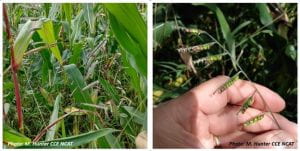Woolly cupgrass (Eriochloa villosa) has always been a grass weed associated with the Midwest. It was first found in Oregon in the 1940s and made its way to Iowa in the 1950s. It was found in Southern Quebec in 2000. Recently, woolly cupgrass was found on a farm in Lewis County; the second known population in New York (see photo). In August 2020, it was first discovered on a farm in Herkimer County, NY.
Woolly cupgrass is an annual weed that can be very tough to control in corn and soybeans. It will germinate very early and continue to germinate throughout the growing season. It has a large seed (approximately 3 to 4x’s larger than foxtail) that can emerge from soil depths as deep as 6 inches. Key identifying characteristics of woolly cupgrass include a hairy leaf blade with one side of the leaf edge that is wavy or crinkled.
It can be a very difficult weed to control, especially in conventional corn because most of the preemergence herbicides are not very effective at providing season long control. The Group 15 acetamide herbicides generally provide very good control of annual grasses; however, they are not as good for the control of woolly cupgrass. Harness, Surpass and Warrant (acetochlor) have been reported to provide slightly better control of woolly cupgrass than Dual II Magnum (metolachlor) or Outlook (dimethenamid). Prowl (pendimethalin) is another soil residual herbicide used in both corn and soybean that is labelled for the control of woolly cupgrass.
In conventional corn, Accent Q (nicosulfuron) and Laudis (tembotrione) will provide postemergence control of woolly cupgrass. Both Roundup (glyphostate) and Liberty (glufosinate) will control emerged woolly cupgrass. Therefore, the use of glyphosate in Roundup Ready corn or glufosinate in Liberty Link corn would be good choices for control of woolly cupgrass.

The discovery of woolly cupgrass, a new weed species in NYS, reinforces the need to always be on the lookout for something different in the field. We must continue to scout fields on a regular basis and watch for new weeds, insects, or plant diseases.
